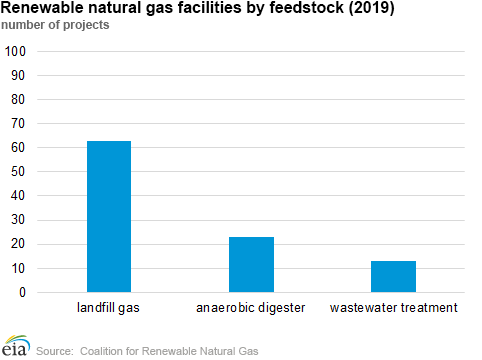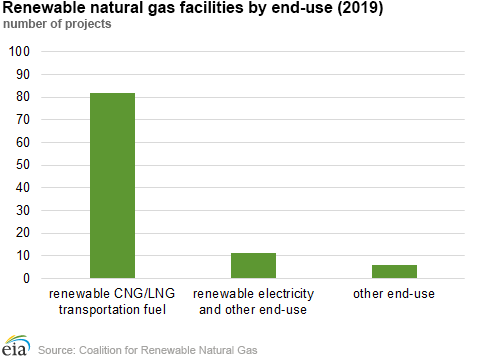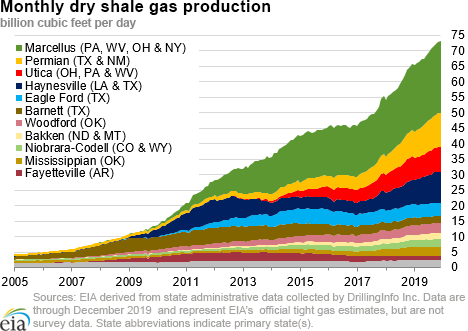In the News:
Smithfield begins renewable natural gas production at its Tar Heel, North Carolina pork processing plant
On January 8, 2020, Smithfield Foods Inc. (Smithfield), the world’s largest pork processor and hog producer, announced that the company is producing renewable natural gas (RNG) at its Tar Heel, North Carolina pork processing plant. RNG projects have increased in recent years, driven by corporate sustainability efforts, state renewable portfolio standards, and biofuels targets.
According to the Coalition for Renewable Natural Gas, the number of RNG facilities in the United States reached nearly 100 in 2019, with 13% located at wastewater treatment facilities. Transportation fuel was classified as the predominant end-use of RNG at 83% of facilities in 2019, followed by renewable electricity at 11% of RNG facilities. About 40 RNG projects are under construction across the United States.
RNG, or biomethane, is derived through the decomposition of organic matter in an anaerobic environment, most often at landfills, wastewater treatment facilities, or dedicated anaerobic digester units. The RNG is cleaned and upgraded to achieve the characteristics of pipeline-quality natural gas, making it suitable to be injected into local natural gas distribution systems.
Smithfield’s project converts wastewater into biogas, which is then upgraded to pipeline-quality natural gas. The project was developed with Duke Energy, a regulated utility that serves approximately 7.7 million retail electric customers, and OptimaBio, LLC, a swine waste-to-energy project developer. The project uses the facility’s three million gallon-per-day wastewater treatment system and an existing anaerobic digester that previously produced biogas to run on-site processes. The modified process collects and upgrades the biogas for injection into the Piedmont Natural Gas system.
The RNG produced at Smithfield’s Tar Heel pork processing facility is purchased by Duke Energy for generation at natural gas-fired power plants. Under North Carolina’s Renewable Energy and Energy Efficiency Portfolio Standard (REPS), Duke Energy is required to generate 0.2% of its retail sales of electricity from swine waste by 2024. Duke Energy entered a contract to purchase RNG from the Smithfield facility over a 15-year period.
According to Smithfield, the project will produce about 370,000 cubic feet per day of RNG, or about 140 million cubic feet per year. The RNG delivered to Duke Energy will produce enough electricity to power more than 2,000 homes and businesses per year.
RNG produced at the Tar Heel facility and other Smithfield facilities and contract farms will help the company achieve its stated goal to reduce greenhouse gas emissions from its domestic operations 25% by 2025, relative to a 2010 baseline.
Overview:
(For the week ending Wednesday, January 22, 2019)
- Natural gas spot prices fell at most locations this report week (Wednesday, January 15 to Wednesday, January 22). The Henry Hub spot price fell from $1.98 per million British thermal units (MMBtu) last Wednesday to $1.89/MMBtu yesterday.
- At the New York Mercantile Exchange (Nymex), the price of the February 2020 contract decreased 22¢, from $2.120/MMBtu last Wednesday to $1.905/MMBtu yesterday. Tuesday’s contract price of $1.895/MMBtu was the lowest price for a February contract since 1999. The price of the 12-month strip averaging February 2020 through January 2021 futures contracts declined 13¢/MMBtu to $2.156/MMBtu.
- The net withdrawal from working gas totaled 92 billion cubic feet (Bcf) for the week ending January 17. Working natural gas stocks total 2,947 Bcf, which is 23% more than the year-ago level and 9% more than the five-year (2015–19) average for this week.
- The natural gas plant liquids composite price at Mont Belvieu, Texas, fell by 15¢/MMBtu, averaging $4.90/MMBtu for the week ending January 22. The prices of ethane, propane, and butane fell by 8%, 7%, and 2%, respectively. The prices of natural gasoline and isobutane rose by 1% and 5%, respectively.
- According to Baker Hughes, for the week ending Tuesday, January 14, the natural gas rig count increased by 1 to 120. The number of oil-directed rigs rose by 14 to 673. The total rig count increased by 15, and it now stands at 796.
Prices/Supply/Demand:
Prices fall as the Henry Hub posts the lowest January price in more than 20 years. This report week (Wednesday, January 15 to Wednesday, January 22), the Henry Hub spot price fell 9¢ from $1.98/MMBtu last Wednesday to a low of $1.89/MMBtu yesterday, the lowest January price since 1999. Temperatures across the Lower 48 states were generally warmer than normal except in the Northeast and Midwest regions, where it was cooler than normal. At the Chicago Citygate, the price decreased 17¢ from $1.97/MMBtu last Wednesday to a low of $1.80/MMBtu yesterday.
California prices are down with more temperate weather. The price at PG&E Citygate in Northern California fell 41¢, down from a high of $3.14/MMBtu last Wednesday to $2.73/MMBtu yesterday. The price at SoCal Citygate in Southern California decreased $1.10 from $4.41/MMBtu last Wednesday to a low of $3.31/MMBtu yesterday as net withdrawals from storage eased.
Northeast prices decline. At the Algonquin Citygate, which serves Boston-area consumers, the price went down $2.35 from $4.46/MMBtu last Wednesday to a low of $2.11/MMBtu yesterday, after reaching a high of $7.38/MMBtu last Thursday, ahead of weekend snow and cold temperatures. At the Transcontinental Pipeline Zone 6 trading point for New York City, the price decreased 15¢ from $2.16/MMBtu last Wednesday to a low of $2.01/MMBtu yesterday.
The Tennessee Zone 4 Marcellus spot price decreased 27¢ from $1.83/MMBtu last Wednesday to $1.56/MMBtu yesterday. The price at Dominion South in southwest Pennsylvania fell 25¢ from $1.79/MMBtu last Wednesday to $1.54/MMBtu yesterday.
Permian Basin prices trade within a narrow range, ending the week at a high. The price at the Waha Hub in West Texas, which is located near Permian Basin production activities, averaged $0.61/MMBtu last Wednesday, $1.37/MMBtu lower than the Henry Hub price. Yesterday, the price at the Waha Hub averaged a high of $0.80/MMBtu, $1.09/MMBtu lower than the Henry Hub price, narrowing the differential to the Henry Hub.
Supply rises. According to data from IHS Markit, the average total supply of natural gas rose by 1% compared with the previous report week. Dry natural gas production decreased by 1% compared with the previous report week. Average net imports from Canada increased by 62% from last week to meet winter demand in Northeast and Midwest markets.
Demand rises, driven by demand for space heating. Total U.S. consumption of natural gas rose by 17% compared with the previous report week, according to data from IHS Markit. In the residential and commercial sectors, consumption increased by 27%, driven by increased heating needs during the first half of the report week. Natural gas consumed for power generation climbed by 15% week over week as demand rose for electricity used in space heating. Industrial sector consumption increased by 3% week over week. Natural gas exports to Mexico decreased 7% with maintenance on the Sur de Texas–Tuxpan pipeline.
U.S. liquefied natural gas (LNG) exports increase week over week. Fifteen LNG vessels (seven from Sabine Pass, two from Corpus Christi, four from Cameron, and one each from Cove Point and Freeport) with a combined LNG-carrying capacity of 54 Bcf departed the United States between January 16 and January 22, 2020, according to shipping data compiled by Bloomberg.
Storage:
The net withdrawal from storage totaled 92 Bcf for the week ending January 17, compared with the five-year (2015–19) average net withdrawal of 194 Bcf and last year's net withdrawal of 152 Bcf during the same week. Working natural gas stocks totaled 2,947 Bcf, which is 251 Bcf more than the five-year average and 554 Bcf more than last year at this time.
According to The Desk survey of natural gas analysts, estimates of the weekly net change to working natural gas stocks ranged from a net withdrawal of 79 Bcf to 103 Bcf, with a median estimate of 90 Bcf.
The average rate of withdrawal from storage is 22% lower than the five-year average so far in the withdrawal season (November through March). If the rate of withdrawal from storage matched the five-year average of 13.5 Bcf/d for the remainder of the withdrawal season, the total inventory would be 1,948 Bcf on March 31, which is 251 Bcf higher than the five-year average of 1,697 Bcf for that time of year.
More storage data and analysis can be found on the Natural Gas Storage Dashboard and the Weekly Natural Gas Storage Report.
See also:
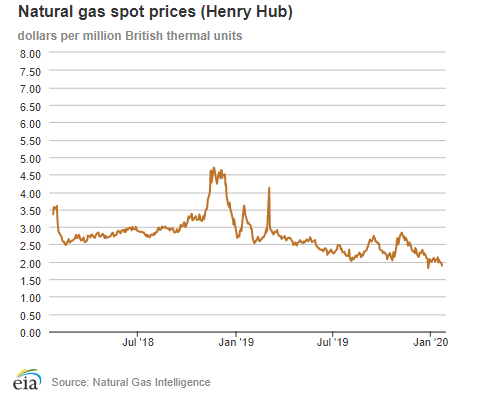
| Spot Prices ($/MMBtu) | Thu, 16-Jan |
Fri, 17-Jan |
Mon, 20-Jan |
Tue, 21-Jan |
Wed, 22-Jan |
|---|---|---|---|---|---|
| Henry Hub | 2.07 | 2.02 | Holiday | 1.95 | 1.89 |
| New York | 2.66 | 3.58 | Holiday | 2.28 | 2.01 |
| Chicago | 2.00 | 1.97 | Holiday | 1.82 | 1.80 |
| Cal. Comp. Avg.* | 3.04 | 2.82 | Holiday | 2.75 | 2.65 |
| Futures ($/MMBtu) | |||||
| February Contract | 2.077 | 2.003 | Holiday | 1.895 | 1.905 |
| March Contract | 2.046 | 1.985 | Holiday | 1.889 | 1.900 |
| *Avg. of NGI's reported prices for: Malin, PG&E Citygate, and Southern California Border Avg. | |||||
| Source: NGI's Daily Gas Price Index | |||||
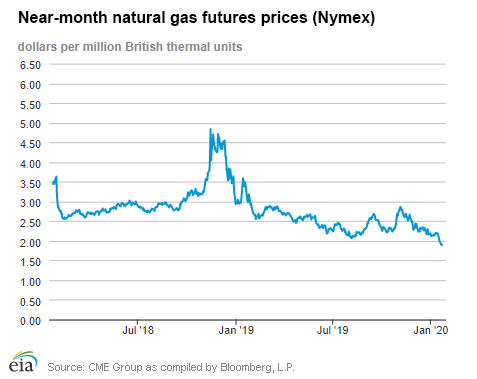
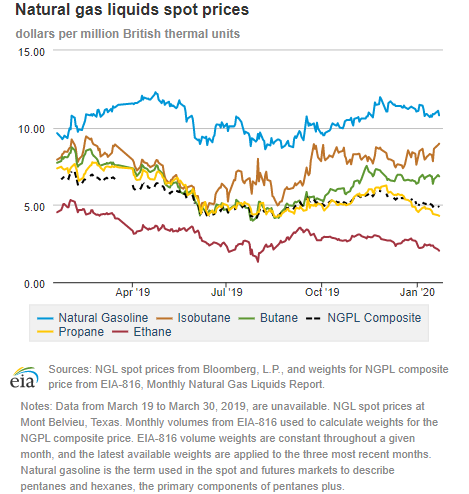
| U.S. natural gas supply - Gas Week: (1/16/20 - 1/22/20) | |||
|---|---|---|---|
Average daily values (Bcf/d): |
|||
this week |
last week |
last year |
|
| Marketed production | 107.5 |
108.6 |
99.1 |
| Dry production | 94.6 |
95.4 |
87.4 |
| Net Canada imports | 5.3 |
3.3 |
6.0 |
| LNG pipeline deliveries | 0.5 |
0.2 |
0.6 |
| Total supply | 100.3 |
98.9 |
94.0 |
|
Source: IHS Markit | |||
| U.S. natural gas consumption - Gas Week: (1/16/20 - 1/22/20) | |||
|---|---|---|---|
Average daily values (Bcf/d): |
|||
this week |
last week |
last year |
|
| U.S. consumption | 106.2 |
90.6 |
103.3 |
| Power | 30.3 |
26.3 |
27.7 |
| Industrial | 25.1 |
24.4 |
25.6 |
| Residential/commercial | 50.8 |
39.9 |
49.9 |
| Mexico exports | 4.9 |
5.3 |
4.9 |
| Pipeline fuel use/losses | 7.6 |
7.3 |
7.2 |
| LNG pipeline receipts | 8.2 |
8.2 |
4.1 |
| Total demand | 126.9 |
111.4 |
119.5 |
|
Source: IHS Markit | |||
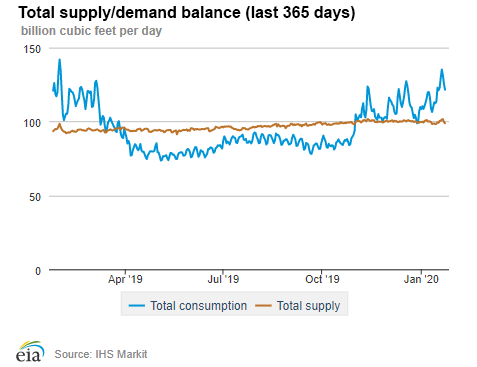
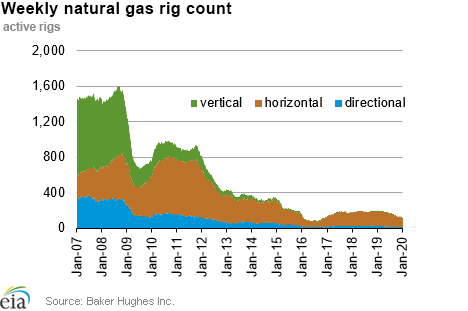
| Rigs | |||
|---|---|---|---|
Tue, January 14, 2020 |
Change from |
||
last week |
last year |
||
| Oil rigs | 673 |
2.1% |
-21.0% |
| Natural gas rigs | 120 |
0.8% |
-39.4% |
| Note: Excludes any miscellaneous rigs | |||
| Rig numbers by type | |||
|---|---|---|---|
Tue, January 14, 2020 |
Change from |
||
last week |
last year |
||
| Vertical | 43 |
13.2% |
-34.8% |
| Horizontal | 709 |
1.6% |
-23.7% |
| Directional | 44 |
-2.2% |
-20.0% |
| Source: Baker Hughes Inc. | |||
| Working gas in underground storage | ||||
|---|---|---|---|---|
Stocks billion cubic feet (Bcf) |
||||
| Region | 2020-01-17 |
2020-01-10 |
change |
|
| East | 696 |
716 |
-20 |
|
| Midwest | 815 |
851 |
-36 |
|
| Mountain | 151 |
161 |
-10 |
|
| Pacific | 220 |
235 |
-15 |
|
| South Central | 1,065 |
1,076 |
-11 |
|
| Total | 2,947 |
3,039 |
-92 |
|
|
Source: Form EIA-912, Weekly Underground Natural Gas Storage Report | ||||
| Working gas in underground storage | |||||
|---|---|---|---|---|---|
Historical comparisons |
|||||
Year ago (1/17/19) |
5-year average (2015-2019) |
||||
| Region | Stocks (Bcf) |
% change |
Stocks (Bcf) |
% change |
|
| East | 574 |
21.3 |
625 |
11.4 |
|
| Midwest | 681 |
19.7 |
736 |
10.7 |
|
| Mountain | 122 |
23.8 |
150 |
0.7 |
|
| Pacific | 187 |
17.6 |
244 |
-9.8 |
|
| South Central | 828 |
28.6 |
940 |
13.3 |
|
| Total | 2,393 |
23.2 |
2,696 |
9.3 |
|
| Source: Form EIA-912, Weekly Underground Natural Gas Storage Report | |||||
| Temperature – heating & cooling degree days (week ending Jan 16) | ||||||||
|---|---|---|---|---|---|---|---|---|
HDD deviation from: |
CDD deviation from: |
|||||||
| Region | HDD Current |
normal |
last year |
CDD Current |
normal |
last year |
||
| New England | 168 |
-106 |
-113 |
0 |
0 |
0 |
||
| Middle Atlantic | 155 |
-107 |
-118 |
0 |
0 |
0 |
||
| E N Central | 204 |
-93 |
-72 |
0 |
0 |
0 |
||
| W N Central | 297 |
-22 |
27 |
0 |
0 |
0 |
||
| South Atlantic | 68 |
-116 |
-125 |
19 |
11 |
15 |
||
| E S Central | 72 |
-119 |
-114 |
1 |
-1 |
1 |
||
| W S Central | 68 |
-73 |
-61 |
13 |
10 |
13 |
||
| Mountain | 229 |
-6 |
22 |
0 |
0 |
0 |
||
| Pacific | 141 |
18 |
26 |
0 |
-1 |
0 |
||
| United States | 161 |
-65 |
-54 |
5 |
3 |
4 |
||
|
Note: HDD = heating degree day; CDD = cooling degree day Source: National Oceanic and Atmospheric Administration | ||||||||
Average temperature (°F)
7-day mean ending Jan 16, 2020
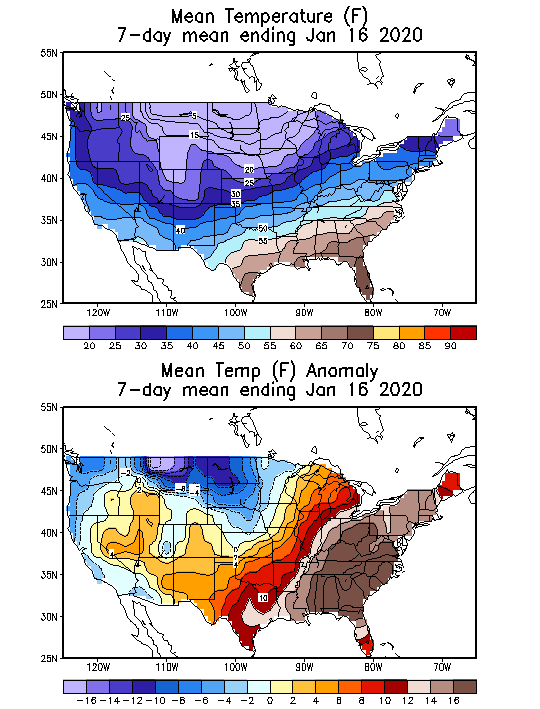
Source: National Oceanic and Atmospheric Administration
Deviation between average and normal (°F)
7-day mean ending Jan 16, 2020

Source: National Oceanic and Atmospheric Administration

